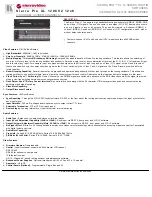
86
C
HAPTER
4: P
ATH
B
UILDER
S700 M
ODULE
AND
A
PPLICATION
O
VERVIEW
timer expires. You can also use the user interface to add static forwarding
addresses that the bridge will not delete after the aging timer expires.
When the packet arrives, the bridge looks up the destination MAC address to
determine the destination of the packet from the forwarding tables. If the
destination is found, the bridge forwards the packet to the correct destination. If
the destination is not found, the bridge broadcasts or floods the packet on all
PVCs that are tied to the particular port. If you have assigned a multicast PVC for
that particular port, the bridge will forward the packet to the port multicast VC
instead of broadcasting it.
The PathBuilder S700 performs LLC-based multiplexing per RFC 1483, and
Ethernet frames are bridged.
Filtering
The first bridging operation determines if the packet is to be processed and
transmitted across the bridge or filtered out based on the list of protocols and
addresses input as part of the PathBuilder S700 configuration. Filtering gives you
control over who communicates with whom in the network. The CPU reads the
header of each packet to determine the protocol, source address, and destination
address and then looks in the list to see if the packet should be passed through
the bridge. If it is to be filtered out, it is cleared from memory.
Addressing
The next bridging operation determines if a packet is addressed to another unit on
the LAN (in which case it can be rejected) or if it is addressed to a unit across the
bridge.
As mentioned above, each Ethernet packet includes a source address and a
destination address in its header. These are MAC addresses which are unique
physical addresses assigned to every Ethernet interface on every Ethernet LAN.
Packet transmission from one unit to another on the same LAN is accomplished
easily. However, packet transmission between units on different LANs requires a
higher-level addressing scheme.
Learning Bridge
The aggregate of VPIs/VCIs assigned to a slot and port (Ethernet connection) of
the PathBuilder S700 is referred to as a bridge. Since the PathBuilder S700 reads
and stores MAC addresses and associated VPIs/VCIs as described above, the bridge
is called a learning bridge. Each learning bridge of the PathBuilder S700 has a
separate forwarding table containing the MAC addresses to VPI/VCI associations.
When a learned entry is stored in a forwarding table, it is time tagged. An aging
timer in the PathBuilder S700, which you can set, purges entries from the
forwarding tables after the specified time. The bridges must then relearn purged
addresses. This controls the size of the forwarding tables, particularly in large
networks.
In the PathBuilder S700, each bridge also has a static table associated with it. You
can enter MAC addresses and corresponding PVCs into the static table that you do
not want to be affected by the aging timer. These entries might be for LAN units
that are permanent and are accessed through the ATM network frequently, such
as servers.
Содержание 3C63400-3AC-C - PathBuilder S700 Switch
Страница 14: ...xiv CHAPTER SUPPLEMENTARY REGULATORY INFORMATION ...
Страница 18: ...4 ABOUT THIS GUIDE ...
Страница 28: ...14 CHAPTER 1 SYSTEM DESCRIPTION ...
Страница 88: ...74 CHAPTER 3 GETTING STARTED ...
Страница 260: ...246 CHAPTER 6 PATHBUILDER S700 DIAGNOSTICS AND PERFORMANCE MONITORING ...
Страница 270: ...256 INDEX ...
















































